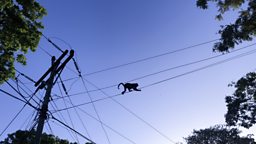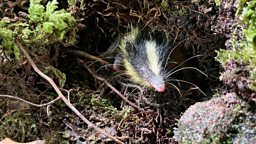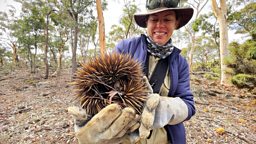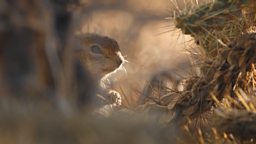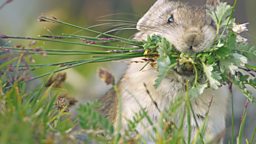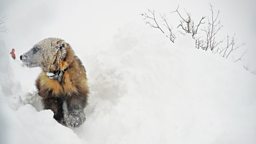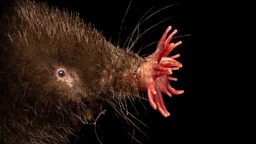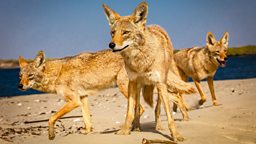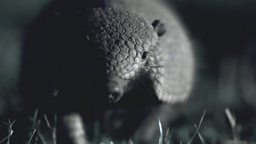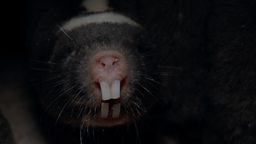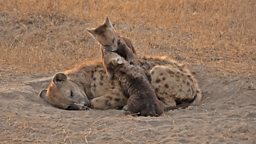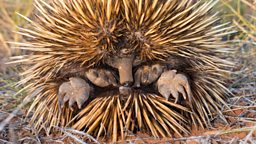The Grinch: A reindeer-hunting polar bear
By Florian Ledoux, Camera Operator for Mammals
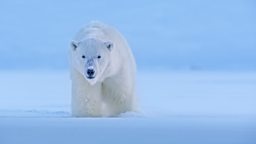
As we stand on the icy expanse of the Arctic, the horizon stretches out before us like an infinite canvas painted with hues of white and blue. The sheer vastness of the landscape overwhelms our senses. Each breath we take crystallizes in the frigid air. Surrounded by a pristine wilderness, we find ourselves immersed in a symphony of silence. In this solitude, we are humble observers, small dots in the grandeur of nature's masterpiece.
The sheer vastness of the landscape overwhelms our senses
During 2022 and 2023, my friend and fellow high Arctic expedition leader, Oskar Strom and I embarked on a mission to document the hunting behaviour of Svalbard’s polar bears for the ���˿���'s Mammals series. Our focus was on bears that have specialized in the unique behaviour of hunting reindeer; a technique which is passed down from mothers to their cubs.
This behaviour has opened new horizons for these bears, as they have proven incredibly efficient in hunting the small, Svalbard reindeer. For a behaviour that was thought by many to be isolated and rare, we have been lucky enough to witness their awe-inspiring ability to kill two reindeer in a single day, which shattered our previous beliefs about their hunting and running capabilities.
To document this incredible behaviour for the ���˿��� Mammals series, I was thrilled to have a chance to work alongside John Shier, a talented long-lens cameraman. Our mission would be difficult, but we knew it was about being at the right place at the right time.

As we all contemplated the idea of being able to stay on the ice, immersed in the powerful Arctic ecosystem, Oskar proposed a brilliant solution to the ���˿��� Mammals team: small, self-contained “pods” meticulously designed to provide us with shelter and the necessities of energy, warmth, and water – 24/7.
These pods, measuring 7.5 feet long and 5 feet wide, were just big enough for two people to sleep in or sit upright in (at 4 feet high). Each was custom-tailored for the harsh Arctic conditions and over time, became our home.
Living in the pods transformed our approach to capturing images in these remote regions, allowing us to intimately engage with the icy expanse for several months of the year. This unique opportunity enabled us to make endless observations of the movement of wildlife, the weather changes, and to understand better each animal.
Living in the “pods” is not just a logistical choice, but an intrinsic immersion that creates an intimate connection with nature.
One of the polar bears we knew to predate on reindeer was an incredible young cub with a unique story and known locally as “the Grinch”. So named for her love for preying on reindeer, the Grinch's journey began when she was a little over a year old. Abandoned by her mother, who ventured into a new courtship with a male, the cub found herself navigating the icy wilderness alone, doing what she knew the best from her mother: taking reindeer.
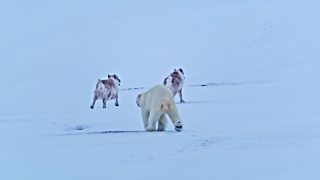
Despite her solitude, the Grinch found comfort and sought company with other individual bears or animals, displaying an insatiable curiosity and playful behaviour that defined her character. Most nights, before hunting reindeer in the mountains, she was seen by the ice edge playing in the cold water. She would pull on seaweed floating amongst the ice floes, catch arctic cod, and jump from the ice after birds. Her interactions with the natural world were as entertaining as they were moving, for us.
After countless days with her and hours of patient observations, one particularly long day saw everything fall into place. The elements aligned, and the whole team was in a perfect place to see and document the Grinch's thrilling hunt.
As time passed that day and she spent energy playing, a sudden shift was noticeable. With her focus intensifying, she took the direction of the hills and tracked the reindeer, stalking her prey with a precision born of instinct. After several hours of tracking, she eventually came upon a small group of reindeer in the mountains. We had to work hard to get into the right positions (me with the drone and John on his long lens), all the while keeping our distance. But once we had, seeing her incredible hunt unfold with my eyes was nothing short of magical, a demonstration of the sheer power and grace of this apex predator.

We returned to the pods feeling exhausted - having been on alert for several days, so the fatigue was setting in. However, we found ourselves unable to stop watching the footage we had just captured. The thrill of the chase lingered on, leaving us restless and unable to sleep! Eventually, exhaustion caught up with us and we dozed off, but soon after, she was back on the hunt and so we were up again. This was a memory that would stay with me forever.

The Grinch’s hunts were a testament to the resilience and adaptability of her species; showing them able to sprint over long distances with breath-taking speed and agility.
Although, like most polar bears the Grinch was opportunistic, she (and the other reindeer-hunting polar bears we have seen) appear fitter; enabling them to run at speeds of up to 8 m/s for an average duration of 1 minute and 30 seconds. The longest chase we observed from the Grinch was 3 minutes and 50 seconds – and this she undertook after stalking the reindeer for more than 20 minutes!
Beyond her role as a predator, the Grinch became more than a polar bear, she became a friend that we could recognize by her incredible character. So, when news of her death reached our ears in early June 2023, two weeks after we last saw her healthy, it sent shockwaves through us, and we couldn’t hold back our tears. Found lifeless, her once vibrant spirit extinguished, the circumstances surrounding the Grinch's death remain unknown.
Suspicions of a bacterial or viral infection emerged with the discovery of dead arctic foxes in her vicinity that most likely ate on the carcass. Though she may be gone, her memory lives on through this ���˿��� series, a tribute to the enduring legacy of a creature whose spirit roamed the icy landscapes of Svalbard and reminds us of the fragility of life in the Arctic wilderness.
Though she may be gone, her memory lives on through this ���˿��� series
In Svalbard, many animal populations are on a slow but steady recovery from centuries of heavy hunting, which once brought them perilously close to extinction. Whether polar bears will disappear with less sea ice remains unanswered, as it is not yet known how their hunting of reindeer or other sources of food might sustain them. As a result, it is crucial to continue studying their behaviour to understand the implications of climate change.
A polar bear hunts reindeer
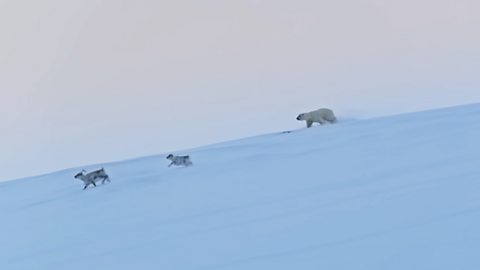
A polar bear hunts reindeer
A polar bear ventures into the mountains to hunt reindeer on the Svalbard archipelago.


